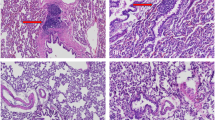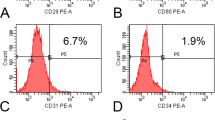Abstract
The role that transduced mouse bone marrow stromal cells (mBMSCs) engineered to overexpress human bone morphogenetic protein 2 (BMP-2) play in healing critical-sized skeletal defects is largely unknown. We evaluated the interaction between host osteoprogenitor cells and donor mBMSCs transduced with either a lentiviral (LV) vector-expressing red fluorescent protein (RFP) with or without BMP-2 that were implanted into a critical-sized femoral defect. Radiographs taken at the time of killing were evaluated using a five-point scaled scoring system. Frozen histologic sections were analyzed to assess both the transduced cells’ role in bone repair and the local osteoprogenitor response. There was complete radiographic bridging in 94% of group I (LV-RFPch-BMP-2-cmyc) and 100% of group III (recombinant human BMP-2) specimens. Radiographs demonstrated a lack of healing in group II (LV-RFPch). Mouse BMSCs transduced with an LV-RFPch-BMP-2 vector were able to induce host cells to differentiate down an osteoblastic lineage and heal a critical-sized defect. However, the donor cells appeared to be functioning as a delivery vehicle of BMP-2 rather than actually differentiating into osteoblasts capable of participating in bone repair as evidenced by a lack of colocalization of the transduced cells to the sites of skeletal repair where the host progenitor cells were found.
This is a preview of subscription content, access via your institution
Access options
Subscribe to this journal
Receive 12 print issues and online access
$259.00 per year
only $21.58 per issue
Buy this article
- Purchase on Springer Link
- Instant access to full article PDF
Prices may be subject to local taxes which are calculated during checkout








Similar content being viewed by others
References
Silber JS, Anderson DG, Daffner SD, Brislin BT, Leland JM, Hilibrand AS et al. Donor site morbidity after anterior iliac crest bone harvest for single-level anterior cervical discectomy and fusion. Spine (Phila PA 1976) 2003; 28: 134–139.
Younger EM, Chapman MW . Morbidity at bone graft donor sites. J Orthop Trauma 1989; 3: 192–195.
Mastrogiacomo M, Muraglia A, Komlev V, Peyrin F, Rustichelli F, Crovace A et al. Tissue engineering of bone: search for a better scaffold. Orthod Craniofac Res 2005; 8: 277–284.
Lieberman JR, Daluiski A, Stevenson S, Wu L, McAllister P, Lee YP et al. The effect of regional gene therapy with bone morphogenetic protein-2-producing bone-marrow cells on the repair of segmental femoral defects in rats. J Bone Joint Surg Am 1999; 81: 905–917.
Park J, Ries J, Gelse K, Kloss F, von der Mark K, Wiltfang J et al. Bone regeneration in critical size defects by cell-mediated BMP-2 gene transfer: a comparison of adenoviral vectors and liposomes. Gene Therapy 2003; 10: 1089–1098.
Shen HC, Peng H, Usas A, Gearhart B, Fu FH, Huard J . Structural and functional healing of critical-size segmental bone defects by transduced muscle-derived cells expressing BMP4. J Gene Med 2004; 6: 984–991.
Hsu WK, Sugiyama O, Park SH, Conduah A, Feeley BT, Liu NQ et al. Lentiviral-mediated BMP-2 gene transfer enhances healing of segmental femoral defects in rats. Bone 2007; 40: 931–938.
Peterson B, Zhang J, Iglesias R, Kabo M, Hedrick M, Benhaim P et al. Healing of critically sized femoral defects, using genetically modified mesenchymal stem cells from human adipose tissue. Tissue Eng 2005; 11: 120–129.
Virk MS, Sugiyama O, Park SH, Gambhir SS, Adams DJ, Drissi H et al. ‘Same day’ ex-vivo regional gene therapy: a novel strategy to enhance bone repair. Mol Ther 2011; 19: 960–968.
Bertone AL, Pittman DD, Bouxsein ML, Li J, Clancy B, Seeherman HJ . Adenoviral-mediated transfer of human BMP-6 gene accelerates healing in a rabbit ulnar osteotomy model. J Orthop Res 2004; 22: 1261–1270.
Baltzer AW, Lattermann C, Whalen JD, Wooley P, Weiss K, Grimm M et al. Genetic enhancement of fracture repair: healing of an experimental segmental defect by adenoviral transfer of the BMP-2 gene. Gene Therapy 2000; 7: 734–739.
Virk MS, Conduah A, Park SH, Liu N, Sugiyama O, Cuomo A et al. Influence of short-term adenoviral vector and prolonged lentiviral vector mediated bone morphogenetic protein-2 expression on the quality of bone repair in a rat femoral defect model. Bone 2008; 42: 921–931.
Evans CH, Liu FJ, Glatt V, Hoyland JA, Kirker-Head C, Walsh A et al. Use of genetically modified muscle and fat grafts to repair defects in bone and cartilage. Eur Cell Mater 2009; 18: 96–111.
Lee JY, Peng H, Usas A, Musgrave D, Cummins J, Pelinkovic D et al. Enhancement of bone healing based on ex vivo gene therapy using human muscle-derived cells expressing bone morphogenetic protein 2. Hum Gene Ther 2002; 13: 1201–1211.
Musgrave DS, Pruchnic R, Bosch P, Ziran BH, Whalen J, Huard J . Human skeletal muscle cells in ex vivo gene therapy to deliver bone morphogenetic protein-2. J Bone Joint Surg Br 2002; 84: 120–127.
Aslan H, Zilberman Y, Arbeli V, Sheyn D, Matan Y, Liebergall M et al. Nucleofection-based ex vivo nonviral gene delivery to human stem cells as a platform for tissue regeneration. Tissue Eng 2006; 12: 877–889.
Miyazaki M, Zuk PA, Zou J, Yoon SH, Wei F, Morishita Y et al. Comparison of human mesenchymal stem cells derived from adipose tissue and bone marrow for ex vivo gene therapy in rat spinal fusion model. Spine (Phila PA 1976) 2008; 33: 863–869.
Uludag H, D'Augusta D, Palmer R, Timony G, Wozney J . Characterization of rhBMP-2 pharmacokinetics implanted with biomaterial carriers in the rat ectopic model. J Biomed Mater Res 1999; 46: 193–202.
Miyazaki M, Sugiyama O, Zou J, Yoon SH, Wei F, Morishita Y et al. Comparison of lentiviral and adenoviral gene therapy for spinal fusion in rats. Spine (Phila PA 1976) 2008; 33: 1410–1417.
Feeley BT, Conduah AH, Sugiyama O, Krenek L, Chen IS, Lieberman JR . In vivo molecular imaging of adenoviral versus lentiviral gene therapy in two bone formation models. J Orthop Res 2006; 24: 1709–1721.
Gamradt SC, Abe N, Bahamonde ME, Lee YP, Nelson SD, Lyons KM et al. Tracking expression of virally mediated BMP-2 in gene therapy for bone repair. Clin Orthop Relat Res 2006; 450: 238–245.
Gazit D, Turgeman G, Kelley P, Wang E, Jalenak M, Zilberman Y et al. Engineered pluripotent mesenchymal cells integrate and differentiate in regenerating bone: a novel cell-mediated gene therapy. J Gene Med 1999; 1: 121–133.
Koefoed M, Ito H, Gromov K, Reynolds DG, Awad HA, Rubery PT et al. Biological effects of rAAV-caAlk2 coating on structural allograft healing. Mol Ther 2005; 12: 212–218.
Ito H, Koefoed M, Tiyapatanaputi P, Gromov K, Goater JJ, Carmouche J et al. Remodeling of cortical bone allografts mediated by adherent rAAV-RANKL and VEGF gene therapy. Nat Med 2005; 11: 291–297.
Repic D, Torreggiani E, Franceschetti T, Matthews BG, Ivcevic S, Lichtler AC et al. Utilization of transgenic models in the evaluation of osteogenic differentiation of embryonic stem cells. Connect Tissue Res 2013; 54: 296–304.
Bakhtina A, Tohfafarosh M, Lichtler A, Arinzeh TL . Characterization and differentiation potential of rabbit mesenchymal stem cells for translational regenerative medicine. In Vitro Cell Dev Biol Anim 2014; 50: 251–260.
Alaee F, Sugiyama O, Virk MS, Tang H, Drissi H, Lichtler AC et al. Suicide gene approach using a dual-expression lentiviral vector to enhance the safety of ex vivo gene therapy for bone repair. Gene Therapy 2014; 21: 139–147.
Kung SK, An DS, Chen IS . A murine leukemia virus (MuLV) long terminal repeat derived from rhesus macaques in the context of a lentivirus vector and MuLV gag sequence results in high-level gene expression in human T lymphocytes. J Virol 2000; 74: 3668–3681.
Sugiyama O, An DS, Kung SP, Feeley BT, Gamradt S, Liu NQ et al. Lentivirus-mediated gene transfer induces long-term transgene expression of BMP-2 in vitro and new bone formation in vivo. Mol Ther 2005; 11: 390–398.
Alaee F, Hong SH, Dukas AG, Pensak MJ, Rowe DW, Lieberman JR . Evaluation of osteogenic cell differentiation in response to bone morphogenetic protein or demineralized bone matrix in a critical sized defect model using GFP reporter mice. J Orthop Res 2014; 32: 1120–1128.
Jiang X, Kalajzic Z, Maye P, Braut A, Bellizzi J, Mina M et al. Histological analysis of GFP expression in murine bone. J Histochem Cytochem 2005; 53: 593–602.
Ushiku C, Adams DJ, Jiang X, Wang L, Rowe DW . Long bone fracture repair in mice harboring GFP reporters for cells within the osteoblastic lineage. J Orthop Res 2010; 28: 1338–1347.
Alaee F, Hong SH, Dukas AG, Pensak MJ, Rowe DW, Lieberman JR . Evaluation of osteoprogenitor cell response to bone morphogenetic protein and demineralized bone matrix in a critical sized defect model using GFP reporter mice. Orthopaedic Reserch Society Annual Meeting: San Antonio, TX, USA, 26–29 January 2013.
Hong SH JX, Chen L, Shin DG, Rowe D (eds). An update on automated 2D bone histomorphometry. XIIth Congress of the International Society of Bone Morphometry: Minneapolis, MN, USA, 16–19 October 2012.
Hong SH, Jiang X, Chen L, Josh P, Shin DG, Rowe D . Computer-automated static, dynamic and cellular bone histomorphometry. J Tissue Sci Eng 2012 (Suppl 1): 004.
Parfitt AM, Drezner MK, Glorieux FH, Kanis JA, Malluche H, Meunier PJ et al. Bone histomorphometry: standardization of nomenclature, symbols, and units. Report of the ASBMR Histomorphometry Nomenclature Committee. J Bone Miner Res 1987; 2: 595–610.
Otsu N . A threshold selection method from gray-scale histogram. IEEE Trans Systems, Man and Cybernetics 1978; 9: 62–66.
Acknowledgements
Dr Lieberman’s work has been supported by the National Institutes of Health (grant number 7RO1AR057076-04).
Author information
Authors and Affiliations
Corresponding author
Ethics declarations
Competing interests
The authors declare no conflict of interest.
Rights and permissions
About this article
Cite this article
Pensak, M., Hong, S., Dukas, A. et al. The role of transduced bone marrow cells overexpressing BMP-2 in healing critical-sized defects in a mouse femur. Gene Ther 22, 467–475 (2015). https://doi.org/10.1038/gt.2015.14
Received:
Revised:
Accepted:
Published:
Issue Date:
DOI: https://doi.org/10.1038/gt.2015.14
This article is cited by
-
The preparation and application of calcium phosphate biomedical composites in filling of weight-bearing bone defects
Scientific Reports (2021)
-
Limited potential of AAV-mediated gene therapy in transducing human mesenchymal stem cells for bone repair applications
Gene Therapy (2021)
-
Poly(POG)n loaded with recombinant human bone morphogenetic protein-2 accelerates new bone formation in a critical-sized bone defect mouse model
Journal of Orthopaedic Surgery and Research (2020)
-
Regulated ex vivo regional gene therapy for bone repair using an inducible caspase-9 suicide gene system
Gene Therapy (2019)
-
Gene activated adipose tissue fragments as advanced autologous biomaterials for bone regeneration: osteogenic differentiation within the tissue and implications for clinical translation
Scientific Reports (2019)



